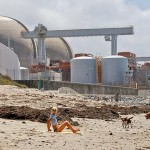Below is a practical dilemma for the authorities in one area of California, so which would you shutdown: a nuclear power generator or a coal fired power generator? Either way you lose a little; either way you win a little.
This reinforces the view that there are no easy answers when it comes to energy security and environmental sustainability.
Troubles at a 1960s-Era Nuclear Plant in California May Hint at the Future
All that changed, however, after the Fukushima Daiichi meltdown in Japan last year, followed in January by a small leak of radioactive steam here caused by the deterioration of steam tubes that had been damaged by vibration and friction. The twin generators at the San Onofre plant have been off-line for five months, and the plant has subsequently become a point of contention in the fight over nuclear power in the United States.
The leak has galvanized opposition to the nuclear plant among local residents, who are calling for San Onofre to remain shuttered for good.
Antinuclear activists from across the country have seized on problems at San Onofre as an opportunity to push California toward a future without nuclear power.
“A lot of people have gotten involved since Fukushima, and now especially since San Onofre has been closed,” said Gary Headrick, the founder of San Clemente Green, a local environmental organization. “It’s really not worth living with this risk. We should shut it down.”
The plant will remain shut through at least the end of the summer while the Nuclear Regulatory Commission and Southern California Edison, the utility company that operates it, investigate the cause of the leak from the steam tubes.
Officials have said repeatedly that the generators will restart only if they are deemed safe.
Still, any efforts to permanently close the nuclear plant face the ever-growing appetite for electricity in Southern California. San Onofre, the largest power plant in the region, produced 2,200 megawatts, enough to power 1.4 million homes, and also helps import power to the region.
The absence of these reactors is being felt now as Southern California moves into the hot summer months. Two retired generators from a natural gas plant have been temporarily fired up, and state energy officials have encouraged the public to conserve energy during peak hours.
Without any power from San Onofre, a severe heat wave could bring rolling blackouts, but state energy officials said they expected to get through the summer without problems.
“If we have a high-heat wave, and we don’t get cooperation from the public, we could have issues,” said Stephen Berberich, president of the California Independent System Operator, a nonprofit agency that manages the flow of electricity in the state.
In 2009 and 2010, Southern California Edison spent nearly $700 million — financed by ratepayers — to install two new steam generators, which were supposed to keep San Onofre’s aging reactors running well into the future.
But in June, federal regulatory officials announced that faulty computer modeling caused the generators’ steam tubes to deteriorate much more quickly than expected, which led to the leak in January.
Lara Uselding, a spokeswoman for the Nuclear Regulatory Commission, called the leaks “unprecedented,” and said there was no plan for when the plant might be allowed to restart or what fixes would have to be made before then. Southern California Edison declined to make a spokesman available and responded to questions with a short written statement. “There is no timeline on safety,” it said.
Local and national antinuclear activists say they will be satisfied only when the nuclear plant is shut down for good.
Maria Mattioli, 44, is one of the area residents who have spoken to government officials in municipalities around the plant in recent months, urging them to lobby federal regulators to keep the plant closed.
“I think it’s very important that we take a very close look at San Onofre and possibly shut it down,” Ms. Mattioli said. “My heart says shut it down. I don’t want to uproot myself and move to Arizona or somewhere else.”
Damon Moglen, a spokesman for Friends of the Earth, notes that California already has a law that prevents the construction of nuclear reactors, and said the shutdown at San Onofre gives the state an opportunity to prepare for the day when both its nuclear plants are shut down.
“You cannot run San Onofre and Diablo Canyon forever,” Mr. Moglen said, referring to the state’s only other nuclear plant, in San Luis Obispo County. “California could be the first really big state to come to grips with a post-nuclear energy program.”
For the moment, though, California energy officials may have few options aside from nuclear power — which remains relatively inexpensive to produce and does not add to greenhouse gases — especially if they hope to meet aggressive goals for reducing the state’s carbon emissions by 2020.
“We are really faced with a choice, at least in the next decade,” said Per Peterson, a professor of engineering at the University of California, Berkeley. “Do we turn off nuclear plants first, or do we turn off coal plants first? You have to do one or the other.”





